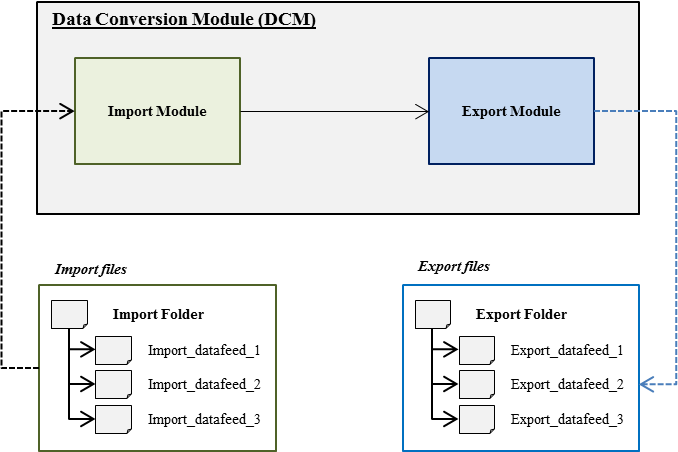...
Variant 1: Import, Export.
This is the simplest workflow variant. The workflow only consists out of an import and an export module. This variant can be used when the original import files already have the correct timestep and when location specific transformations are not needed. In this case the DCM is mainly used to convert the file format of the import files. In the Figure below a schematic illustration of this workflow variant is given.
Figure 11 Simplest workflow variant in DCM. The DCM is only used for conversion of the file format, there is no need for transformations.
Note (1): If you need to use LocationSets.xml for transformations than it is also necessary to add a Locations.xml to your Config/RegionConfigFiles folder.
Note (2): If you need to use IdMapping or Unitconversion than it is necessary to add a Parameters.xml to your Config/RegionConfigFiles folder.
The DCM support the TimeSeriesImportRun module. This implies that all import types available within Delft-FEWS are also available to the DCM. To minimize the amount of configuration, it is possible to configure imports without having to specify the timeseries information in the import module. Here is an example for importing PI-Xml:
| Code Block | ||
|---|---|---|
| ||
<?xml version="1.0" encoding="UTF-8"?> <timeSeriesImportRun xmlns="http://www.wldelft.nl/fews" xmlns:xsi="http://www.w3.org/2001/XMLSchema-instance" xsi:schemaLocation="http://www.wldelft.nl/fews http://fews.wldelft.nl/schemas/version1.0/timeSeriesImportRun.xsd"> <import> <general> <importType>LmwWeatherdata</importType> <folder>$IMPORT_FOLDER_ROOT$/LMW_maasaa</folder> <idMapId>IdImport_LMWmaasaa</idMapId> </general> <temporary>true</temporary> </import> </timeSeriesImportRun> |
In the above example it can be seen that the configuration of TimeSeriesSets has been replaced by the element ‘temporary’. This way it is no longer necessary to configure locations and parameters in the RegionConfig directory. These are generated on-the-fly during the import process. All imported data is stored as temporary data and will only be available to other tasks that are being executed within the same workflow as the import module. However, if you want to make use of the locationSets than it is necessary to configure both the locations and the locationSets in the RegionConfig directory.
As is the case with the import run, the export no longer requires the configuration of TimeSeriesSets. The export run will automatically export all data imported in the previous import actions of the same workflow run. Here is an example for exporting PI-xml:
| Code Block | ||
|---|---|---|
| ||
<timeSeriesExportRun xmlns="http://www.wldelft.nl/fews" xmlns:xsi="http://www.w3.org/2001/XMLSchema-instance" xsi:schemaLocation="http://www.wldelft.nl/fews http://fews.wldelft.nl/schemas/version1.0/timeSeriesExportRun.xsd"> <export> <general> <exportType>NETCDF-CF_TIMESERIES</exportType> <folder>$EXPORT_FOLDER_ROOT$/LMW_maasaa</folder> <exportFileName> <name>_LMWmaasaa.nc</name> <prefix> <timeZeroFormattingString>yyyy-MM-dd'T'HHmmss</timeZeroFormattingString> </prefix> </exportFileName> <unitConversionsId>ExportUnitConversions</unitConversionsId> <exportMissingValueString>-9999.0</exportMissingValueString> <exportTimeZone> <timeZoneOffset>+01:00</timeZoneOffset> </exportTimeZone> </general> <properties> <bool value="false" key="includeFlags"/> <bool value="false" key="includeComments"/> </properties> <metadata> <title>Export of LMW_maasaa datafeed</title> <institution>Deltares</institution> <history>Exported at time zero = %TIME_ZERO(yyyy/MM/dd HH:mm:ss z)% in module instance %MODULE_INSTANCE_ID% as part of workflow %WORKFLOW_NAME% by user %USER_ID%.</history> <comment>The actual time of writing was %CURRENT_TIME(yyyy-MM-dd HH:mm:ss z)%</comment> </metadata> </export> </timeSeriesExportRun> |
It is possible to filter the data that is to be exported by configuring TimeSeriesSet information. But in that case the locations and parameter information must be added to the export configuration (see export example in Variant 2).
Variant 2: Import, Transformation, Export.
...
